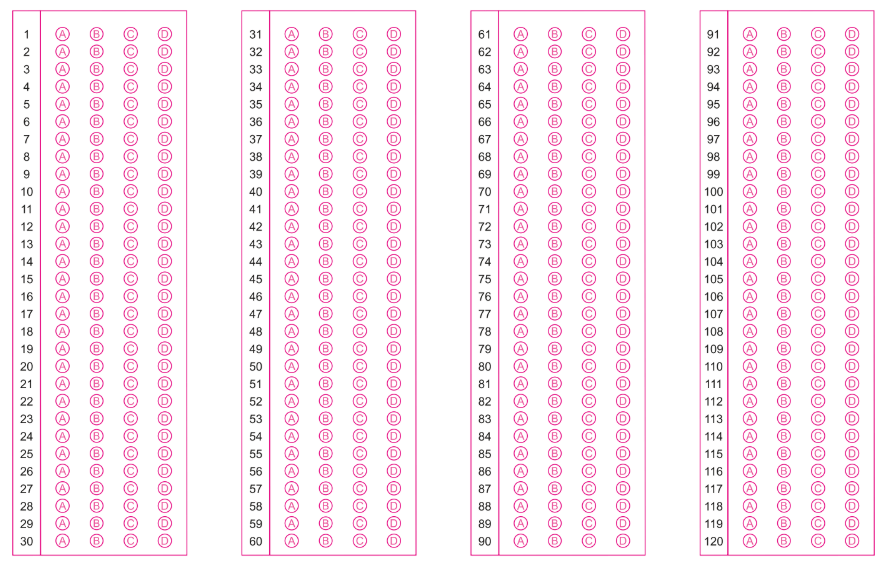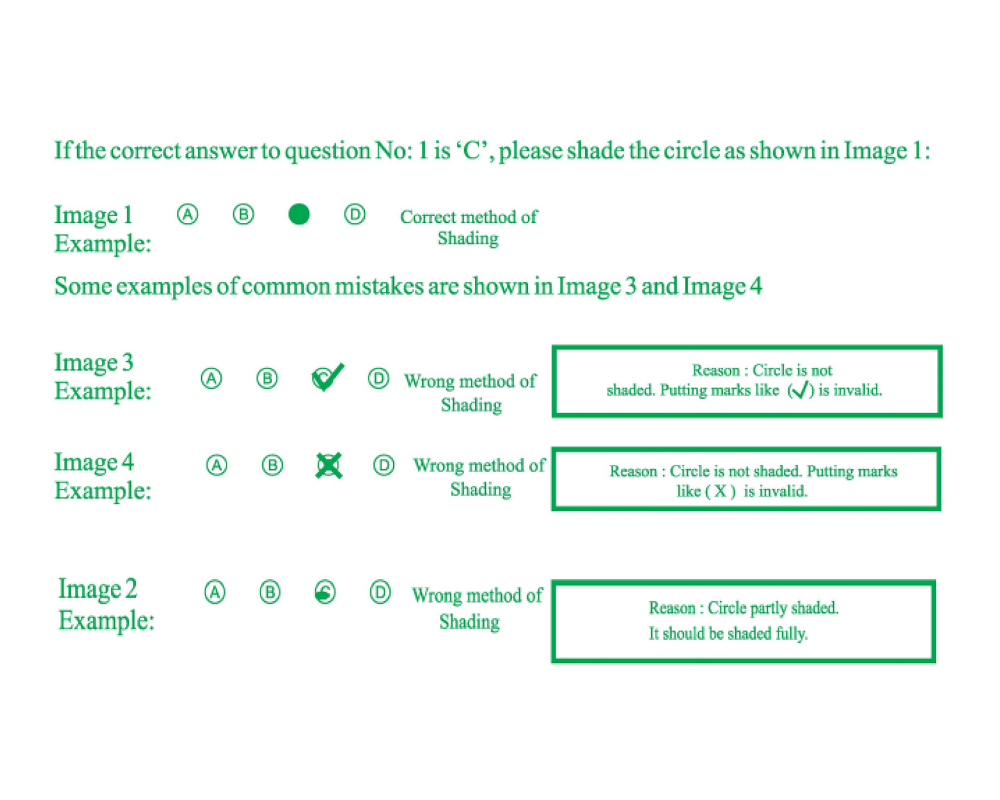Filling the CLAT OMR Sheet 2026 accurately is a crucial part of the exam process, as even minor errors can affect your score. The OMR sheet is where you record your answers, and understanding the proper way to fill it can save you from unnecessary penalties.
This blog provides a detailed guide on how to fill the CLAT OMR sheet correctly, common mistakes to avoid, and effective strategies to manage your time.
Additionally, we’ve included a downloadable CLAT OMR Sheet PDF to help you practice and perfect your technique before exam day. Prepare smartly for a stress-free experience!
Upcoming CLAT Exams:
What is OMR Sheet?
The full form of OMR sheet is Optical Mark Recognition. It is a specialized paper used in exams like CLAT to record candidates’ answers. The sheet contains pre-printed bubbles corresponding to question numbers, which candidates fill in using a blue or black ballpoint pen.
OMR sheets are designed to be scanned by optical devices that detect the filled bubbles and evaluate answers accurately. They are highly sensitive to markings, making correct and careful filling crucial for proper evaluation.
For CLAT, the OMR sheet serves as your official answer sheet, and its accurate completion directly impacts your exam results.

CLAT OMR Sheet Layout
The CLAT 2026 OMR sheet is divided into different sections that candidates must fill carefully.
Answer Marking Section
Question Numbers and Answer Bubbles: The OMR sheet for CLAT 2026 contains question numbers in columns with corresponding options (A, B, C, D).
You must darken the bubble that corresponds to your chosen answer for each question.
Ensure the bubbles are filled completely without stray marks.
Correct Marking Method
Correct Marking Method: Use only a blue or black ballpoint pen. Fill the bubble completely and avoid marking outside the circle.
Marking Examples:
The sheet clearly demonstrates incorrect methods such as partial marking, stray marks, or marking more than one bubble.

How to Fill OMR Sheet for CLAT 2026?
Accurately filling the OMR sheet of CLAT is crucial to ensure your answers are evaluated correctly. Follow these steps to avoid any mistakes:
1. Use the Right Pen
Use only a blue/black ballpoint pen to fill the bubbles on the CLAT 2026 OMR sheet.
Avoid using gel pens, pencils, or markers, as they are not allowed and may lead to scanning issues.
2. Fill Answers Systematically
- Locate the question number on the OMR sheet that matches the one you are attempting in the CLAT 2025 question paper.
- Darken the bubble (A, B, C, or D) corresponding to your answer for that question.
- Ensure you darken the bubble completely without leaving stray marks or partially filled bubbles.
3. Cross-Check Your Entries
Match the question number in the paper with the number on the CLAT OMR sheet to avoid mismatches. Verify your answers before marking to minimize overwriting or mistakes.
4. Avoid Multiple Markings
Mark only one bubble for each question. If you darken more than one bubble, it will be considered incorrect and result in a penalty of -0.25 marks.
5. Handle the OMR Sheet Carefully
- Do not fold, tear, or tamper with the OMR sheet of CLAT 2026.
- Avoid making stray marks or writing anywhere outside the designated fields.
- Keep the sheet clean and free from smudges.
6. Leave No Questions Unanswered
If unsure about an answer, leave the bubble blank instead of guessing to avoid negative marking. Use your judgment to decide whether to attempt or skip questions.
7. Post-Exam Submission
Before handing over the sheet, ensure:
- All mandatory fields are filled.
- No stray marks are present.
- Submit the CLAT 2026 OMR sheet to the invigilator as instructed and retain your candidate’s copy.
8. Practice with CLAT OMR Sheet PDF
Download a CLAT 2026 OMR sheet PDF for practice and familiarize yourself with the format to ensure speed and accuracy on the exam day.
Choosing the Right CLAT OMR Sheet Filling Strategy
One of the critical aspects of exam success lies in deciding when to fill your OMR sheet. The right strategy can ensure accuracy, save time, and prevent costly mistakes.
Here are three widely used approaches for CLAT 2026, and other competitive exams:
1. Fill After Each Question
Mark the OMR sheet immediately after solving each question.
Advantages:
- Reduces the risk of forgetting to fill the OMR sheet.
- Avoids confusion about which answers were completed.
- Ensures every attempted question is recorded promptly.
Best For: Candidates who prefer systematic progress and want to avoid last-minute errors or rushes.
2. Fill After Each Section
Solve all the questions in a section or subsection first, then mark all answers for that section on the OMR sheet.
Advantages:
- Maintains focus on solving questions without frequent interruptions.
- Creates a rhythm for managing time effectively within each section.
- Reduces the risk of mismatched question numbers compared to filling at the end.
Best For: Those who work well with a section-wise time allocation strategy.
3. Fill at the End of the Paper
Attempt all the questions first and mark all answers on the OMR sheet in one go, just before time runs out.
Advantages:
- Allows uninterrupted focus on solving questions.
- Maximizes time utilization for answering tough questions.
- Prevents frequent switching between solving and filling tasks.
Risks:
- If time runs out unexpectedly, unfilled responses will result in zero scores.
- Requires strict time management and a backup plan.
Best For: Candidates confident in their ability to manage time and work under pressure.
Which Strategy Should You Choose?
- Consider your speed, accuracy, and ability to manage stress under timed conditions.
- Practice each method during mock tests to identify which works best for you.
- No matter the approach, allocate time toward the end of the exam to double-check your CLAT OMR sheet for errors.
Importance of Correctly Filling CLAT OMR Sheet 2026
1. Accurate Score Evaluation
Properly filling the CLAT 2026 OMR Sheet ensures that the scanner reads your answers accurately, directly affecting your score.
2. Avoiding Negative Marking
Correctly marking answers minimizes the chances of errors like double marking, which can lead to penalties.
3. Time Efficiency
Practicing with a CLAT OMR sheet PDF helps you develop a strategy to fill answers quickly and efficiently, saving time during the exam.
4. No Rejection of OMR Sheet
Incorrect details like roll number or stray marks can result in the sheet being rejected during evaluation.
5. Eliminating Stress
Knowing how to fill the CLAT OMR sheet correctly reduces anxiety and allows you to focus on solving questions.
6. Consistency in Answering
Following proper guidelines ensures a systematic approach, avoiding mismatches between question numbers and answers.
7. Avoiding Loss of Marks
Carelessly filled bubbles or improper markings can lead to unrecognized answers, resulting in a lower score.
8. Compliance with Exam Guidelines
Adhering to rules for handling the CLAT OMR Sheet 2026 prevents disqualification due to non-compliance.
9. Preparation for the Actual Exam
Practicing with a CLAT 2026 OMR sheet familiarizes you with real exam conditions and builds confidence.
10. Improved Accuracy
Careful handling and proper filling techniques minimize the chances of human error during the marking process.
Important Resources After CLAT Exam:
| CLAT Result 2025 | CLAT 2025 Toppers |
| NLSIU Bangalore | CLAT 2025 Question Paper |
| CLAT Cut Off | NLSIU Bangalore Fee Structure |
| CLAT Counselling 2025 | CLAT Allotment List 2025 |
| CLAT Marks vs Rank | CLAT Rank Predictor |
Common Mistakes to Avoid While Filling CLAT OMR Sheet
Below is a list of mistakes to avoid while handling the CLAT OMR sheet:
1. Not Filling the Bubbles Completely
Ensure you darken the bubbles fully without leaving gaps. Partially filled or lightly marked bubbles may not be read by the scanner.
2. Multiple Markings for One Question
Mark only one bubble per question. Double-marked answers will be treated as incorrect and attract a negative marking penalty.
3. Incorrect Alignment of Question Numbers
Always match the question number in the booklet with the corresponding number on the CLAT OMR sheet. Misaligned answers can lead to incorrect evaluation.
4. Stray Marks or Extra Writing
Avoid making stray marks or writing anything outside the designated areas. Extra marks can confuse the scanner and invalidate your sheet.
5. Overwriting or Using Correction Fluid
Do not attempt to overwrite or use correction fluid on the OMR sheet. Such actions make the response invalid for that question.
6. Damaging the OMR Sheet
Do not fold, tear, or tamper with the OMR sheet. Physical damage can cause scanning errors or rejection of the sheet.
7. Ignoring Personal Information Sections
Ensure all personal details are accurately filled in as per the instructions. Missing or incorrect details can disqualify your OMR sheet.
8. Not Checking Question Paper Code
Verify that the question paper code matches the one filled on your OMR sheet. Mismatched codes may invalidate your responses.
9. Failing to Practice with a Sample OMR Sheet
Download and practice with a PDF of CLAT OMR sheet beforehand to familiarize yourself with the layout and avoid mistakes during the exam.
Free CLAT Study Material for You:
| CLAT Previous Year Papers PDF | CLAT Sample Papers |
| CLAT Syllabus PDF | Free CLAT Coaching |
| CLAT Current Affairs | CLAT Topper Interviews |
| CLAT Videos | CLAT Mock Tests |
How CLAT OMR Sheet is Evaluated?
The evaluation of the CLAT OMR sheets is conducted through a computerized process to ensure accuracy and fairness:
1. Scanning of OMR Sheets
The CLAT OMR sheets are scanned using Optical Mark Recognition (OMR) technology, which identifies the darkened bubbles corresponding to the answers.
The scanner detects the markings based on their opacity and shape, ensuring that only properly filled bubbles are read.
2. Matching Question Numbers and Responses
The system matches the marked answers on the OMR sheet with the correct answers in the answer key provided by the Consortium.
Each question’s response is validated against the official answer key for scoring.
3. Scoring Rules Applied
- For each correct answer, +1 mark is awarded.
- For every incorrect answer, -0.25 marks are deducted as per the negative marking scheme.
- No marks are awarded or deducted for unanswered questions.
Know more about the CLAT Marking Scheme.
4. Handling Double Marking
If more than one bubble is marked for a single question, it is treated as a wrong answer, and -0.25 marks are deducted.
5. Error Checks
The system checks for discrepancies, such as mismatched question numbers or stray marks, which can affect evaluation.
Sheets with significant issues (e.g., missing roll numbers, incorrect booklet codes) may be flagged for manual review.
6. Generating the Final Score
The total score is calculated by applying the marking scheme to all attempted questions. The final score for each candidate is generated and recorded in the result database.
7. Rank Calculation
Based on the calculated scores, candidates are ranked in descending order. In case of ties, tiebreaker rules (such as higher age or Legal Reasoning scores) are applied to assign ranks.
Know about CLAT Marks vs Rank
8. Publishing the Results
After evaluation, the CLAT results are compiled, and the final scores are uploaded to the official website.
Candidates can view their scores and rank by logging into their account or downloading the result PDF.
Download CLAT OMR Sheet PDF
By practicing with a free CLAT OMR sheet PDF, you can familiarize yourself with the layout and marking process. This will boost your confidence, ensure accuracy, and save precious time during the exam.
Download the free PDF now to practice marking your answers and perfect your strategy for handling the OMR sheet!
FAQs About CLAT OMR Sheet
Yes, the CLAT exam is OMR-based, and candidates need to fill their answers on an OMR sheet using a ballpoint pen.
The full form of OMR is “Optical Mark Recognition.”
Use a blue or black ballpoint pen, as per the official guidelines for the CLAT exam.
No, gel pens are not allowed. Only blue or black ballpoint pens can be used.
No, erasing or using correction fluid is not permitted. Once marked, the answer cannot be changed.
Stay calm and correct the sequence in the remaining questions. Avoid further mismatches.
Yes, candidates are allowed to take the candidate copy of the OMR sheet, as per the exam guidelines.
For each incorrect answer, 0.25 marks are deducted as per the CLAT marking scheme.
Yes, but only answered questions will be evaluated. Unmarked questions do not affect your score.
No, extra time is not provided. You must complete it within the allotted exam duration.
Must Know for Every CLAT Aspirant:
| CLAT Eligibility Criteria | CLAT Exam Pattern |
| CLAT Age Limit | CLAT Marking Scheme |
| How to Prepare for CLAT? | Best Books for CLAT |
Law Colleges Information Related to CLAT:



